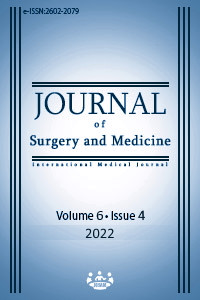Effect of warming different intravenous fluids on maternal and neonatal outcomes during cesarean section - comparison of crystalloids and colloids
Keywords:
Hypothermia, Crystalloids, Colloids, Maternal core temperature, Neonatal core temperature, Apgar scoreAbstract
Background/Aim: Fluid warming is a useful method to prevent maternal and neonatal hypothermia. Because colloids stay in the intravascular space longer than crystalloids, their protective effect against hypothermia may be more emphasized. The aim of this study is to compare the effects of using warmed colloids or crystalloids on maternal and neonatal core temperatures, neonatal blood gas values, and maternal thermal comfort scores. Methods: After ethical approval, 220 ASA I or II pregnant women, scheduled for cesarean section with spinal anesthesia were enrolled in the study. Patients were assigned to receive hydroxyethyl starch (group HES) or Ringer’s lactate solution (group RL) throughout the intraoperative study period. Once the patient entered the room, fluids were actively warmed with fluid warmer to 41 °C in both groups. Measurement of maternal core temperature (MT) and thermal comfort score (TCS) were performed before starting intravenous fluid administration (control), at the time of delivery of the neonate (delivery), 15th, 30th minutes, and at the end of the surgery. Tympanic temperature of the neonates was measured 1 minute after delivery. Blood gas samples from the umbilical artery of the neonates at the 1st minute and Apgar scores at 1st and 5th minutes after delivery were evaluated. Results: Maternal tympanic temperatures, maternal thermal comfort scores were higher at all measurement values other than control measurement in group HES. Neonatal tympanic temperatures (P=0.051), neonatal umbilical artery cord pH (P<0.001) and pO2 (P=0.001) values were higher and pCO2 (P<0.001) and HCO3 (P<0.001) values were lower in group HES. Conclusion: Colloids are more effective than crystalloids in terms of maternal and neonatal temperatures and thermal comfort scores. Even if there was no difference between Apgar scores in our study, for neonates with potential vulnerabilities, better umbilical artery cord values may provide clinical advantages.
Downloads
References
Chan AMH, Ng KFJ, Tong EWN, Jan GSK. Control of shivering under regional anesthesia in obstetric patients with tramadol. Can J Anesthesia. 1999;46(3):253–8.
Liu WH, Luxton MC. The effect of prophylactic fentanyl on shivering in elective caesarean section under epidural analgesia. Anaesthesia. 1991;46(5):344–8.
Horn E-P, Bein B, Steinfath M, Ramaker K, Buchloh B, Höcker J. The Incidence and Prevention of Hypothermia in Newborn Bonding after Cesarean Delivery. Anesthesia Analgesia. 2014;118(5):997–1002.
Leadford AE, Warren JB, Manasyan A, Chomba E, Salas AA, Schelonka R, et al. Plastic Bags for Prevention of Hypothermia in Preterm and Low Birth Weight Infants. Pediatrics. 2013;132(1):e128–34.
Frank SM, El-Rahmany HK, Cattaneo CG, Barnes RA. Predictors of hypothermia during spinal anesthesia. Anesthesiology. 2000;92(5):1330–4.
Toit L du, Dyk D van, Hofmeyr R, Lombard CJ, Dyer RA. Core Temperature Monitoring in Obstetric Spinal Anesthesia Using an Ingestible Telemetric Sensor. Obstetric Anesthesia Dig. 2018;38(2):107–8.
Ueyama H, He YL, Tanigami H, Mashimo T, Yoshiya I. Effects of crystalloid and colloid preload on blood volume in the parturient undergoing spinal anesthesia for elective Cesarean section. Anesthesiology. 1999;91(6):1571–6.
Yokoyama K, Suzuki M, Shimada Y, Matsushima T, Bito H, Sakamoto A. Effect of administration of pre-warmed intravenous fluids on the frequency of hypothermia following spinal anesthesia for Cesarean delivery. J Clin Anesth. 2009;21(4):242–8.
Yamakage M, Sasaki H, Jeong S-W, Iwasaki S, Namiki A. Safety and beneficial effect on body core temperature of a prewarmed plasma substitute—hydroxyethyl starch—during anesthesia. J Anesth. 2004;18(3):166–71.
Matsukawa T, Sessler DI, Christensen R, Ozaki M, Schroeder M. Heat Flow and Distribution during Epidural Anesthesia. Anesthesiology. 1995;83(5):961–7.
Hynson JM, Sessler DI, Glosten B, McGuire J. Thermal Balance and Tremor Patterns during Epidural Anesthesia. Anesthesiology. 1991;74(4):680–90.
Ozaki M, Kurz A, Sessler DI, Lenhardt R, Schroeder M, Moayeri A, et al. Thermoregulatory Thresholds during Epidural and Spinal Anesthesia. Anesthesiology. 1994;81(2):282–8.
Sultan P, Habib AS, Cho Y, Carvalho B. The Effect of patient warming during Caesarean delivery on maternal and neonatal outcomes: a meta-analysis. Bja Br J Anaesth. 2015;115(4):500–10.
Gilbert RD, Schroder H, Kawamura T, Dale PS, Power GG. Heat transfer pathways between fetal lamb and ewe. J Appl Physiol. 1985;59(2):634–8.
Astrup P, Engel K, Severinghaus JW, Munson E. The Influence of Temperature and Ph on the Dissociation Curve of Oxyhemoglobin of Human Blood. Scand J Clin Laboratory Investigation. 1965;17(6):515–23
Downloads
- 609 551
Published
Issue
Section
How to Cite
License
Copyright (c) 2022 Nihan Aydın Güzey, Havva Esra Uyar Türkyılmaz
This work is licensed under a Creative Commons Attribution-NonCommercial-NoDerivatives 4.0 International License.
















